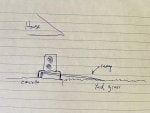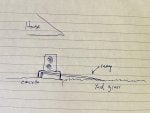I live in Northern Montana and had a Mitsubishi heat pump installed 4 months ago (MXZ SM48NAMHZ-U1). It has been working great but due to the fact it was placed in my breezeway we have an issue when it cycles and lets out water in below freezing temps. You get a bunch of ice which is hard to deal with and damaging to the side of the house and walkway. I have been placing a plastic underbed box underneath and emptying it a few times a day on the most humid of days. Obviously this is a less than ideal solution.
My installer built a drain pan with some heater wire in it feeding to a pvc pipe coming out the side with some wire around it. The problem with this solution that I expect to discover next winter is there is no slope, and the pipe would drain only when the low height drain pan (~2”) is essentially full. The small pvc pipe barely makes it past the edge of my house and I believe fairly quickly a huge ice dam would form at the exit of the pipe and I’d be no better off.
My current idea is to build a 10” wide by 8ft plywood ramp with a small lip that can fit underneath the bottom of the heat pump and drain farther into the yard. I will put a heat-track mat on the ramp to prevent the water from freezing on the ramp. My belief is this would not get blocked by ice buildup nearly as easily as a small PVC pipe, and it will be significantly farther into the yard, reducing problems with buildup.
My old man also had an idea of using a small heater device designed to keep livestock troughs from freezing, placing that in a deeper drip tray underneath the heat pump with a level sensor that causes a small pump to evacuate water out into the yard until the water level is just *above* the pump, keeping the pump submersed in liquid water. This solution is complex and prone to error IMO.
I’m wondering if there is a better solution commonly employed in cold climates with heat pumps placed where the condensation can’t safely drain directly under the pump.
I see Mitsubishi sells a drain pan, but all that does is collect the water and release it from a single hole. This drain pain would also need a base pan heater and I’d need a heated hose to get it outside the breezeway and in the yard. I also think the same problem of the tip of the hose being susceptible to becoming clogged…. This would also be something I’d have to pay the installer to do now as their plan was to wait and see how their solution works. I don’t want to find out the hard way by having a huge ice dam form and require implementing rushed alternate solutions in the bitter cold.
Thanks for reading, any tips or suggestions greatly appreciated!
![]()
![]()
My installer built a drain pan with some heater wire in it feeding to a pvc pipe coming out the side with some wire around it. The problem with this solution that I expect to discover next winter is there is no slope, and the pipe would drain only when the low height drain pan (~2”) is essentially full. The small pvc pipe barely makes it past the edge of my house and I believe fairly quickly a huge ice dam would form at the exit of the pipe and I’d be no better off.
My current idea is to build a 10” wide by 8ft plywood ramp with a small lip that can fit underneath the bottom of the heat pump and drain farther into the yard. I will put a heat-track mat on the ramp to prevent the water from freezing on the ramp. My belief is this would not get blocked by ice buildup nearly as easily as a small PVC pipe, and it will be significantly farther into the yard, reducing problems with buildup.
My old man also had an idea of using a small heater device designed to keep livestock troughs from freezing, placing that in a deeper drip tray underneath the heat pump with a level sensor that causes a small pump to evacuate water out into the yard until the water level is just *above* the pump, keeping the pump submersed in liquid water. This solution is complex and prone to error IMO.
I’m wondering if there is a better solution commonly employed in cold climates with heat pumps placed where the condensation can’t safely drain directly under the pump.
I see Mitsubishi sells a drain pan, but all that does is collect the water and release it from a single hole. This drain pain would also need a base pan heater and I’d need a heated hose to get it outside the breezeway and in the yard. I also think the same problem of the tip of the hose being susceptible to becoming clogged…. This would also be something I’d have to pay the installer to do now as their plan was to wait and see how their solution works. I don’t want to find out the hard way by having a huge ice dam form and require implementing rushed alternate solutions in the bitter cold.
Thanks for reading, any tips or suggestions greatly appreciated!







